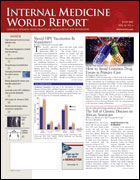Publication
Article
Internal Medicine World Report
Check for Secondary Hyperparathyroidism in Older Patients with Osteoporosis
Author(s):
Bisphosphonates May Exacerbate Calcium Malabsorption
SEATTLE—Before prescribing a bisphosphonate for the treatment of osteoporosis in older patients (≥70 years), it is important to first check for secondary hyperparathyroidism, which appears to be common in that age-group, suggested researchers who presented their study results at the American Geriatrics Society annual meeting.
The study, which focused on women, shows that hyperparathyroidism is more common in women aged ≥70 years than in younger women.
"With elderly patients, it may be beneficial to assess for secondary hyperparathyroidism, because it appears they may not absorb and metabolize calcium as well as a younger woman would. Older patients may need higher levels of vitamin D therapy," said coinvestigator Neerja Bhardwaj, MD, MPH, assistant clinical professor of medicine at Columbia University College of Physicians and Surgeons, New York City.
Most current guidelines for the diagnosis and treatment of osteoporosis are based on studies with younger (<70 years) postmenopausal women. The goal of this retrospective, cross-sectional study was to evaluate for biochemical evidence of calcium malabsorption and secondary hyperparathyroidism in 131 ambulatory women (>55 years) with osteoporosis.
N
The women were grouped by age—55 to 69 years (n = 62) and ≥70 years (n = 69). Measurement parameters included baseline 24-hour urinary calcium, serum 25-hydroxyvitamin D, intact parathyroid hormone (PTH), bone-specific alkaline phosphatase, urinary -telopeptide, calcium, and phosphorus levels.
The cutoff values used to suggest calcium malabsorption or secondary hyperparathyroidism were 24-hour urinary calcium <100 mg/day, 25-hydroxyvitamin D <12 ng/mL, and PTH >65 pg/mL.
Women in the older age-group were more likely to have elevated PTH levels and decreased urinary calcium excretions; however, vitamin D levels did not differ between the 2 age-groups (Table).
IMWR
"This is an issue that needs to be looked at more carefully. There are several important clinical implications," Dr Bhardwaj told . "First, it underscores the importance of assessing calcium metabolism, especially in older women with osteoporosis."
She said that these findings suggest that physicians may need to determine "PTH levels as part of the routine evaluation before considering additional treatment options. Uncorrected calcium deficits could induce hypocalcemia in patients exposed to bisphosphonates or potentially diminish the therapeutic response to such treatments."
She added, "Although Vitamin D deficiency is common in the elderly, measuring only vitamin D levels would have missed patients with secondary hyperparathyroidism. The provision of adequate calcium and correcting hyperparathyroidism is important for bone health."
Table. Calcium malabsorption/secondary hyperparathyroidism parameters
Parameter (mean)
Group 1:
55-69 yr (n = 62)
Group 2:
≥70 yr (n = 69)
P
Age, yr
64.4 ± 4
75.7 ± 4.5
<.001
Weight, kg
63.9 ± 9.2
60.3 ± 10.9
.05
PTH, pg/mL
38.5 ± 16.4
45.9 ± 20.9
.03
25-Hydroxyvitamin D, ng/mL
28.1 ± 10.5
28.8 ± 11.2
.72
Calcium, mg/dL
9.5 ± 0.4
9.4 ± 0.4
.56
Phosphate, mg/dL
3.5 ± 0.4
3.6 ± 0.4
.06
Bone alkaline phosphatase, ng/mL
24.2 ± 10.4
20.2 ± 9.8
.03
N
Urinary -telopeptides,
nmol BCE per mmol/L
252 ± 191
259 ± 185
.67
Urinary calcium, mg/d
155 ± 86
123 ± 65
.02
Note: Log-transformed data analyzed.






